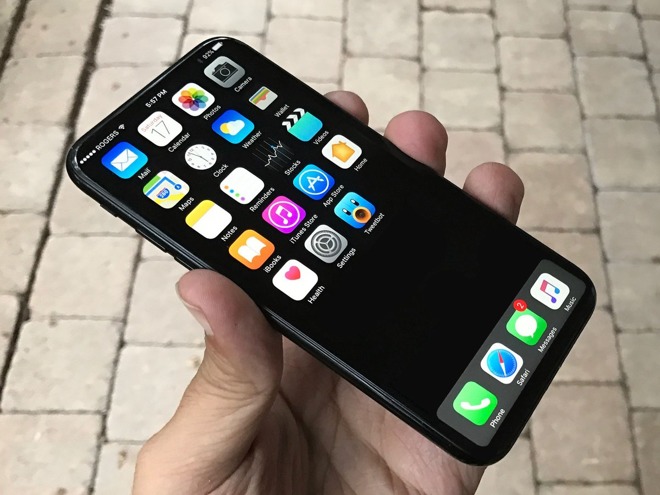AppleInsider podcast talks iPhone and USB-C, iPads instead of Mac, and the meaning of 'pro...
This week on the AppleInsider podcast, Neil and Victor talk about USB-C and iOS devices, iPads as computer replacements, and what the definition of "pro" is.
AppleInsider editors Neil Hughes and Victor Marks discuss:
Listen to the embedded SoundCloud feed below:
Show note links:
Feedback and comments are always appreciated. Please contact the AppleInsider podcast at [email protected] and follow us on Twitter @appleinsider, plus Facebook and Instagram.
Those interested in sponsoring the show can reach out to us at [email protected].
AppleInsider editors Neil Hughes and Victor Marks discuss:
- Apple launches new series of iPad Pro ads as anticipated hardware refresh looms
- Dan's editorial, "The future of Steve Jobs' iPad vision for Post-PC computing"
- All of Apple's 2017 iPhones will include fast charging via Lightning port, not USB-C
- Eero review: Wi-Fi for the masses
- Neil's review of the D-Link Omna HomeKit camera
Listen to the embedded SoundCloud feed below:
Show note links:
- Apple launches new series of iPad Pro ads as anticipated hardware refresh looms
- Editorial: The future of Steve Jobs' iPad vision for Post-PC computing
- Questionable rumor claims Apple will ditch Lightning for USB-C on OLED 'iPhone 8'
- All of Apple's 2017 iPhones will include fast charging via Lightning port, not USB-C
- Review: eero Wi-Fi is a solid option for Apple's outgoing AirPort
- D-Link's HomeKit-connected Omna 180 is a great pet, baby or nanny cam, but security hounds should look elsewhere
Feedback and comments are always appreciated. Please contact the AppleInsider podcast at [email protected] and follow us on Twitter @appleinsider, plus Facebook and Instagram.
Those interested in sponsoring the show can reach out to us at [email protected].



Comments
Important detail here - you have to have Lightning power connected to the Camera adapter for this to work. Otherwise, the phone doesn't have enough power to run the adapters.
We've done POE (Power over Ethernet) for years. I don't think it's possible to do POE to USB-C to power a Mac laptop, because the power demands are too great. The MacBook Pro uses a 61W supply. Up to 25.5 W is available for a device over POE. In the future, it may be possible to do more - IEEE is looking at standards to allow 55 W and 90-100 W, but we're going to have to get new adapters made up to handle this.
Products like these serve one purpose and one purpose only...the illusion of signal. The concept is no different than any wireless repeater or range extender that has ever existed. By sitting closer to one of these faux nodes, you'll have signal. Full bars! It must be good! Wrong. You are giving up significant bandwidth and latency in these arrangements.
The correct way to setup a network is to WIRE together multiple wireless nodes. Apple's AirPort Extreme's are adept at this and can be easily extended into a true mesh network over Ethernet.
Repeating signal is not the illusion of signal. You increase a little latency, but you don't *have* to give up bandwidth necessarily, especially if we're comparing against another wireless router (like with like, not Wi-Fi vs. Ethernet.) If you gain coverage in places that you formerly would have had no reception at all, that's problem solved for the target consumer for these devices. If you're able to make a connection, load pages, and stream TV over it, it isn't an illusion. I grant you, it's not what you'd want for online gaming, but if you're doing that, you're already using a low latency Ethernet card anyway.
Again, yes, you can create a roaming network with Airport Extremes wired with Ethernet. The number of people with Ethernet in their homes is vanishingly small. The number of people who have complaints about Wi-Fi coverage in home is not insignificant. Wiring routers together with Ethernet isn't reality for most people, and telling them, "get someone to run cat 5e or 6 through your walls and put in wall plates" is a non-starter.
That said, I prefer an ethernet backbone with multiple basestations. No latency or bandwidth hit.
The thing I would say is, overarching all of this, Apple has long been about what a person can do - what's the job to get done, and what impediments can be removed so that the job gets done more easily, more enjoyably? Now, Jobs knew that even if they didn't want to talk speeds and feeds, they certainly had to increase a computer's capabilities, to get to that result. To that end, in the old days, they waltzed Jon Rubenstein on stage to show how processors batch instructions, or do Mac vs PC bake-offs to show which was faster at the same task on the same software product. Those days are gone, because they aren't the underdog with something to prove any longer - in their minds. (In Apple's world, they used to prefer to talk about "can it move data fast enough to edit video" over "what are the specs of the GPU.")
It's possible that's a large mistake - that even when you aren't the underdog, you have to keep proving why your products are the best for a given task every quarter, and they seem to have given up talking about that, taking it as given.
You cannot have the same wireless performance from a satellite node than you can from the primary node. It is impossible. You make the case that the reduced performance might be "good enough" for the user, and I tend to agree that the user will think it is good enough, because they went from 2 bars to 5.
Sorry, I can't ever support the advocation of these products. Even to the non-technies. "Run a wire through the attic or basement" is not asking a lot, even of the non-techies.